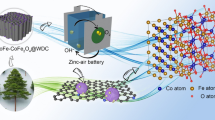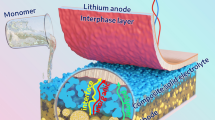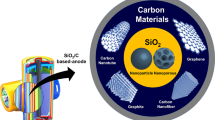Abstract
Developing superhierarchical carbon materials with multiple levels of structural hierarchy including porous structure, hybrid skeleton and/or topological morphology, is highly desirable to fulfill the demands of complex catalytic reactions in electrochemical energy storage and conversion systems. Herein, a class of hierarchical porous cobalt-decorated carbon nanotube bottlebrushes (Co/CNTBs) have been developed by controllably grafting hairy CNTs from the surface of a hybrid CNT backbone with Co nanoparticles as catalytic sites. The well-defined bottlebrush-like topology with hierarchically porous structure provides efficiently accessible surfaces/interfaces and highly conductive networks, while the Co-decorated hybrid skeleton promotes the reaction kinetics of sulfur redox conversion. As a result, an excellent rate capability of 707 mA h g−1 at 10 C and long-term cycling stability can be achieved for lithium-sulfur (Li-S) cells with Co/CNTBs-functionalized separators. Remarkably, the Li-S cell with Co/CNTBs-functionalized separator can deliver a high areal capacity of 4.81 mA h cm−2 after 100 cycles at 0.1 C with a sulfur loading of 6.72 mg cm−2. These findings may shed light on the facile in situ grafting strategy for the fabrication of high-performance superhierarchical carbon hybrids towards numerous challenging applications.

摘要
开发具有多层次结构(包括多孔结构、杂化骨架和/或拓扑形貌)的超结构碳材料, 对于满足电化学储能和转换系统中复杂催化反应的需求非常关键. 在本文中, 我们以钴纳米颗粒为催化位点, 在杂化碳纳米管骨架表面可控接枝毛发状碳纳米管, 开发了一类层次化多孔的钴修饰碳纳米管瓶刷(Co/CNTBs). 其中, 精确的瓶刷状拓扑形貌和分级多孔结构能够有效地提供可及表/界面和高导电网络, 钴修饰的杂化骨架可以促进硫的氧化还原反应动力学. 因此, 基于Co/CNTBs功能化隔膜的锂硫电池具有优异的倍率性能(在10 C下比容量为707 mA h g−1)和长效的循环稳定性. 更重要的是, 基于Co/CNTBs催化剂的高硫载量电池(6.72 mg cm−2)在0.1 C下循环100圈后仍具有4.81 mA h cm−2的高面积容量. 本工作为高性能超结构杂化碳材料的原位接枝合成策略带来了新的思路, 有望用于众多具有挑战性的应用.
Similar content being viewed by others
References
Dunn B, Kamath H, Tarascon JM. Electrical energy storage for the grid: A battery of choices. Science, 2011, 334: 928–935
Lim WG, Kim S, Jo C, et al. A comprehensive review of materials with catalytic effects in Li-S batteries: Enhanced redox kinetics. Angew Chem Int Ed, 2019, 58: 18746–18757
Fan L, Li M, Li X, et al. Interlayer material selection for lithium-sulfur batteries. Joule, 2019, 3: 361–386
Zhang Y, Li X, Fan L, et al. Ultrathin and super-tough membrane for anti-dendrite separator in aqueous zinc-ion batteries. Cell Rep Phys Sci, 2022, 3: 100824
Liang Y, Chen L, Zhuang D, et al. Fabrication and nanostructure control of super-hierarchical carbon materials from heterogeneous bottlebrushes. Chem Sci, 2017, 8: 2101–2106
Liu S, Li J, Yan X, et al. Superhierarchical cobalt-embedded nitrogen-doped porous carbon nanosheets as two-in-one hosts for high-performance lithium-sulfur batteries. Adv Mater, 2018, 30: 1706895
Wu D, Xu F, Sun B, et al. Design and preparation of porous polymers. Chem Rev, 2012, 112: 3959–4015
Lu Y, Tang Y, Liu R, et al. Multifunctional templating strategy for fabrication of Fe, N-codoped hierarchical porous carbon nanosheets. Chin J Polym Sci, 2021, 40: 2–6
Li W, Chen K, Xu Q, et al. Mo2C/C hierarchical double-shelled hollow spheres as sulfur host for advanced Li-S batteries. Angew Chem Int Ed, 2021, 60: 21512–21520
Guo Y, Tang J, Henzie J, et al. Assembly of hollow mesoporous nanoarchitectures composed of ultrafine Mo2C nanoparticles on N-doped carbon nanosheets for efficient electrocatalytic reduction of oxygen. Mater Horiz, 2017, 4: 1171–1177
Cheng Y, Gong J, Cao B, et al. An ingenious strategy to integrate multiple electrocatalytically active components within a well-aligned nitrogen-doped carbon nanotube array electrode for electrocatalysis. ACS Catal, 2021, 11: 3958–3974
Xie W, Li J, Song Y, et al. Hierarchical carbon microtube@nanotube core-shell structure for high-performance oxygen electrocatalysis and Zn-air battery. Nano-Micro Lett, 2020, 12: 97
Xia D, Tang F, Yao X, et al. Seeded growth of branched iron-nitrogen-doped carbon nanotubes as a high performance and durable non-precious fuel cell cathode. Carbon, 2020, 162: 300–307
Luo H, Jiang WJ, Niu S, et al. Self-catalyzed growth of Co-N-C nanobrushes for efficient rechargeable Zn-air batteries. Small, 2020, 16: 2001171
Guo K, Xi B, Wei R, et al. Hierarchical microcables constructed by CoP@Cccarbon framework intertwined with carbon nanotubes for efficient lithium storage. Adv Energy Mater, 2020, 10: 1902913
Cheng N, Wang N, Ren L, et al. In-situ grafting of N-doped carbon nanotubes with Ni encapsulation onto MOF-derived hierarchical hybrids for efficient electrocatalytic hydrogen evolution. Carbon, 2020, 163: 178–185
Du M, Song D, Huang A, et al. Stereoselectively assembled metal-organic framework (MOF) host for catalytic synthesis of carbon hybrids for alkaline-metal-ion batteries. Angew Chem Int Ed, 2019, 58: 5307–5311
Zou L, Hou CC, Liu Z, et al. Superlong single-crystal metal-organic framework nanotubes. J Am Chem Soc, 2018, 140: 15393–15401
Li G, Lei W, Luo D, et al. Stringed “tube on cube” nanohybrids as compact cathode matrix for high-loading and lean-electrolyte lithium-sulfur batteries. Energy Environ Sci, 2018, 11: 2372–2381
Davis BF, Yan X, Muralidharan N, et al. Electrically conductive hierarchical carbon nanotube networks with tunable mechanical response. ACS Appl Mater Interfaces, 2016, 8: 28004–28011
Gupta B, Hossain MA, Riaz A, et al. Recent advances in materials design using atomic layer deposition for energy applications. Adv Funct Mater, 2021, 32: 2109105
Carter R, Davis B, Oakes L, et al. A high areal capacity lithium-sulfur battery cathode prepared by site-selective vapor infiltration of hierarchical carbon nanotube arrays. Nanoscale, 2017, 9: 15018–15026
Lai Q, Zhao Y, Liang Y, et al. In situ confinement pyrolysis transformation of ZIF-8 to nitrogen-enriched meso-microporous carbon frameworks for oxygen reduction. Adv Funct Mater, 2016, 26: 8334–8344
Wang H, Li S, Wang Y, et al. Bioinspired fluffy fabric with in situ grown carbon nanotubes for ultrasensitive wearable airflow sensor. Adv Mater, 2020, 32: 1908214
Na Z, Yao R, Yan Q, et al. Identification of catalytic sites for cerium redox reactions in a metal-organic framework derived powerful electrocatalyst. Energy Storage Mater, 2020, 32: 11–19
Mofokeng TP, Tetana ZN, Ozoemena KI. Defective 3D nitrogen-doped carbon nanotube-carbon fibre networks for high-performance supercapacitor: Transformative role of nitrogen-doping from surface-confined to diffusive kinetics. Carbon, 2020, 169: 312–326
Jo MS, Lee JS, Jeong SY, et al. Golden bristlegrass-like hierarchical graphene nanofibers entangled with N-doped CNTs containing CoSe2 nanocrystals at each node as anodes for high-rate sodium-ion batteries. Small, 2020, 16: 2003391
Sun M, Boo C, Shi W, et al. Engineering carbon nanotube forest superstructure for robust thermal desalination membranes. Adv Funct Mater, 2019, 29: 1903125
Li T, Luo G, Liu K, et al. Encapsulation of Ni3Fe nanoparticles in N-doped carbon nanotube-grafted carbon nanofibers as high-efficiency hydrogen evolution electrocatalysts. Adv Funct Mater, 2018, 28: 1805828
Liu S, Wang Z, Zhou S, et al. Metal-organic-framework-derived hybrid carbon nanocages as a bifunctional electrocatalyst for oxygen reduction and evolution. Adv Mater, 2017, 29: 1700874
Ju Z, Li P, Ma G, et al. Few layer nitrogen-doped graphene with highly reversible potassium storage. Energy Storage Mater, 2018, 11: 38–46
Zhang W, Jiang X, Wang X, et al. Spontaneous weaving of graphitic carbon networks synthesized by pyrolysis of ZIF-67 crystals. Angew Chem Int Ed, 2017, 56: 8435–8440
Wang S, Qin J, Meng T, et al. Metal-organic framework-induced construction of actiniae-like carbon nanotube assembly as advanced multifunctional electrocatalysts for overall water splitting and Zn-air batteries. Nano Energy, 2017, 39: 626–638
Li D, Jia Y, Chang G, et al. A defect-driven metal-free electrocatalyst for oxygen reduction in acidic electrolyte. Chem, 2018, 4: 2345–2356
Li X, Li K, Zhu S, et al. Fiber-in-tube design of Co9S8-carbon/Co9S8: Enabling efficient sodium storage. Angew Chem Int Ed, 2019, 58: 6239–6243
Yan D, Li Y, Huo J, et al. Defect chemistry of nonprecious-metal electrocatalysts for oxygen reactions. Adv Mater, 2017, 29: 1606459
Wang R, Luo C, Wang T, et al. Bidirectional catalysts for liquid-solid redox conversion in lithium-sulfur batteries. Adv Mater, 2020, 32: 2000315
Yue XY, Zhang J, Bao J, et al. Sputtered MoN nanolayer as a multifunctional polysulfide catalyst for high-performance lithium-sulfur batteries. eScience, 2022, 2: 329–338
Jiang B, Tian D, Qiu Y, et al. High-index faceted nanocrystals as highly efficient bifunctional electrocatalysts for high-performance lithium-sulfur batteries. Nano-Micro Lett, 2021, 14: 40
Fan FY, Carter WC, Chiang YM. Mechanism and kinetics of Li2S precipitation in lithium-sulfur batteries. Adv Mater, 2015, 27: 5203–5209
Sun X, Tian D, Song X, et al. In situ conversion to construct fast ion transport and high catalytic cathode for high-sulfur loading with lean electrolyte lithium-sulfur battery. Nano Energy, 2022, 95: 106979
Wang P, Xi B, Zhang Z, et al. Atomic tungsten on graphene with unique coordination enabling kinetically boosted lithium-sulfur batteries. Angew Chem Int Ed, 2021, 60: 15563–15571
Yao W, Zheng W, Xu J, et al. ZnS-SnS@NC heterostructure as robust lithiophilicity and sulfiphilicity mediator toward high-rate and long-life lithium-sulfur batteries. ACS Nano, 2021, 15: 7114–7130
Chen P, Wu Z, Guo T, et al. Strong chemical interaction between lithium polysulfides and flame-retardant polyphosphazene for lithium-sulfur batteries with enhanced safety and electrochemical performance. Adv Mater, 2021, 33: 2007549
Li Y, Gao T, Ni D, et al. Two birds with one stone: Interfacial engineering of multifunctional Janus separator for lithium-sulfur batteries. Adv Mater, 2022, 34: 2107638
Li P, Lv H, Li Z, et al. The electrostatic attraction and catalytic effect enabled by ionic-covalent organic nanosheets on MXene for separator modification of lithium-sulfur batteries. Adv Mater, 2021, 33: 2007803
Li Z, Zhou C, Hua J, et al. Engineering oxygen vacancies in a polysulfide-blocking layer with enhanced catalytic ability. Adv Mater, 2020, 32: 1907444
Li Y, Lin S, Wang D, et al. Single atom array mimic on ultrathin MOF nanosheets boosts the safety and life of lithium-sulfur batteries. Adv Mater, 2020, 32: 1906722
Li G, Lu F, Dou X, et al. Polysulfide regulation by the zwitterionic barrier toward durable lithium-sulfur batteries. J Am Chem Soc, 2020, 142: 3583–3592
Zhang L, Liu D, Muhammad Z, et al. Single nickel atoms on nitrogen-doped graphene enabling enhanced kinetics of lithium-sulfur batteries. Adv Mater, 2019, 31: 1903955
Xue W, Yu D, Suo L, et al. Manipulating sulfur mobility enables advanced Li-S batteries. Matter, 2019, 1: 1047–1060
Pei F, Lin L, Fu A, et al. A two-dimensional porous carbon-modified separator for high-energy-density Li-S batteries. Joule, 2018, 2: 323–336
Yang B, Guo D, Lin P, et al. Hydroxylated multi-walled carbon nanotubes covalently modified with tris(hydroxypropyl) phosphine as a functional interlayer for advanced lithium-sulfur batteries. Angew Chem Int Ed, 2022, 61: e202204327
Zhao CX, Li XY, Zhao M, et al. Semi-immobilized molecular electrocatalysts for high-performance lithium-sulfur batteries. J Am Chem Soc, 2021, 143: 19865–19872
Shi N, Xi B, Liu J, et al. Dual-functional NbN ultrafine nanocrystals enabling kinetically boosted lithium-sulfur batteries. Adv Funct Mater, 2022, 32: 2111586
Shi M, Liu Z, Zhang S, et al. A Mott-Schottky heterogeneous layer for Li-S batteries: Enabling both high stability and commercial-sulfur utilization. Adv Energy Mater, 2022, 12: 2103657
Park JS, Park DY, Yang SM, et al. Dimension-controlled N-doped graphitic carbon nanostructures through low-temperature metal-catalyzed transformation from C3N4 for high-performance electrochemical barrier in lithium-sulfur batteries. Carbon, 2022, 196: 304–312
Mao J, Niu D, Huang G, et al. A Ni/Ni2P heterostructure in modified porous carbon separator for boosting polysulfide catalytic conversion. Sci China Mater, 2022, 65: 2453–2462
Dong Y, Cai D, Li T, et al. Sulfur reduction catalyst design inspired by elemental periodic expansion concept for lithium-sulfur batteries. ACS Nano, 2022, 16: 6414–6425
Zhang X, Li G, Zhang Y, et al. Amorphizing metal-organic framework towards multifunctional polysulfide barrier for high-performance lithium-sulfur batteries. Nano Energy, 2021, 86: 106094
Xu J, An S, Song X, et al. Towards high performance Li-S batteries via sulfonate-rich COF-modified separator. Adv Mater, 2021, 33: 2105178
Wu Z, Chen S, Wang L, et al. Implanting nickel and cobalt phosphide into well-defined carbon nanocages: A synergistic adsorption-electrocatalysis separator mediator for durable high-power Li-S batteries. Energy Storage Mater, 2021, 38: 381–388
Wang M, Sun Z, Ci H, et al. Identifying the evolution of selenium-vacancy-modulated MoSe2 precatalyst in lithium-sulfur chemistry. Angew Chem Int Ed, 2021, 60: 24558–24565
Lei D, Shang W, Zhang X, et al. Facile synthesis of heterostructured MoS2-MoO3 nanosheets with active electrocatalytic sites for high-performance lithium-sulfur batteries. ACS Nano, 2021, 15: 20478–20488
Du Z, Guo Y, Wang H, et al. High-throughput production of 1T MoS2 monolayers based on controllable conversion of Mo-based MXenes. ACS Nano, 2021, 15: 19275–19283
Cai Q, Wang J, Jiao Y, et al. All-graphitic multilaminate mesoporous membranes by interlayer-confined molecular assembly. Small, 2021, 17: 2101173
Zhang S, Zhong N, Zhou X, et al. Comprehensive design of the high-sulfur-loading Li-S battery based on MXene nanosheets. Nano-Micro Lett, 2020, 12: 112
Yu Z, Wang B, Liao X, et al. Boosting polysulfide redox kinetics by graphene-supported Ni nanoparticles with carbon coating. Adv Energy Mater, 2020, 10: 2000907
Li Z, Zhang F, Cao T, et al. Highly stable lithium-sulfur batteries achieved by a SnS/porous carbon nanosheet architecture modified celgard separator. Adv Funct Mater, 2020, 30: 2006297
Hu X, Zhong L, Shu C, et al. Versatile, aqueous soluble C2N quantum dots with enriched active edges and oxygenated groups. J Am Chem Soc, 2020, 142: 4621–4630
Yuan H, Peng HJ, Li BQ, et al. Conductive and catalytic triple-phase interfaces enabling uniform nucleation in high-rate lithium-sulfur batteries. Adv Energy Mater, 2019, 9: 1802768
Xie J, Li BQ, Peng HJ, et al. Implanting atomic cobalt within mesoporous carbon toward highly stable lithium-sulfur batteries. Adv Mater, 2019, 31: 1903813
Li BQ, Peng HJ, Chen X, et al. Polysulfide electrocatalysis on framework porphyrin in high-capacity and high-stable lithium-sulfur batteries. CCS Chem, 2019, 1: 128–137
Acknowledgements
This work was supported by the National Natural Science Foundation of China (51872336, 51925308, and 52172061), the National Key Research and Development Program of China (2021YFF0500600), the Pearl River Talent Plan of Guangdong (2017GC010612), the Natural Science Foundation of Guangdong (2021A1515011617), the Fundamental Research Funds for the Central Universities (20lgzd18), and the Science and Technology Program of Guangzhou (202102021111 and 202002020041).
Author information
Authors and Affiliations
Contributions
Wu D conceived the concept and supervised the research. Liu S and Wu D designed the project. Huang J and Leng K synthesized the materials. Huang J, Leng K, and Cen Z performed the material characterization and electrochemical tests. Huang J, Liu S and Wu D wrote the manuscript. Liu R, Zhu Y and Fu R gave some advice on the research. All authors discussed the results and commented on the manuscript.
Corresponding authors
Additional information
Conflict of interest
The authors declare that they have no conflict of interest.
Supplementary information
Experimental details and supporting data are available in the online version of the paper.
Junlong Huang received his PhD degree from Sun Yat-sen University in 2020, under the supervision of Prof. Ruowen Fu. Now he is a postdoctoral fellow in Prof. Dingcai Wu’s group at Sun Yat-sen University. His current research interests lie in the design and preparation of functional polymer materials and their derived carbon materials toward energy storage and conversion.
Kunyi Leng received her Master degree from Sun Yat-sen University in 2020, under the supervision of Prof. Dingcai Wu. She is currently pursuing her PhD degree at the University of Tokyo under the supervision of Prof. Takuzo Aida. Her current research interests include the design and controllable preparation of porous materials.
Shaohong Liu received his PhD degree from Dalian University of Technology in 2016 under the supervision of Prof. Jieshan Qiu. He joined Prof. Dingcai Wu’s group at Sun Yat-sen University as an associate researcher in 2016 and became an associate professor in 2019. His current research interests focus on the design of advanced polymeric and carbonaceous materials for energy storage and conversion.
Dingcai Wu obtained his PhD degree in polymer chemistry and physics from Sun Yat-sen University in 2006. He joined the faculty of Sun Yat-sen University in 2006 and became a full professor in 2014. His current research interests focus on the preparation and applications of advanced functional materials. He currently serves as the deputy director of the Materials Science Institute and Key Laboratory for Polymeric Composite & Functional Materials of Ministry of Education, Sun Yat-sen University.
Electronic Supplementary Material
Rights and permissions
About this article
Cite this article
Huang, J., Leng, K., Cen, Z. et al. Cobalt-decorated carbon nanotube bottlebrushes for boosting polysulfide conversion in lithium-sulfur batteries. Sci. China Mater. 66, 1747–1756 (2023). https://doi.org/10.1007/s40843-022-2303-0
Received:
Accepted:
Published:
Issue Date:
DOI: https://doi.org/10.1007/s40843-022-2303-0




